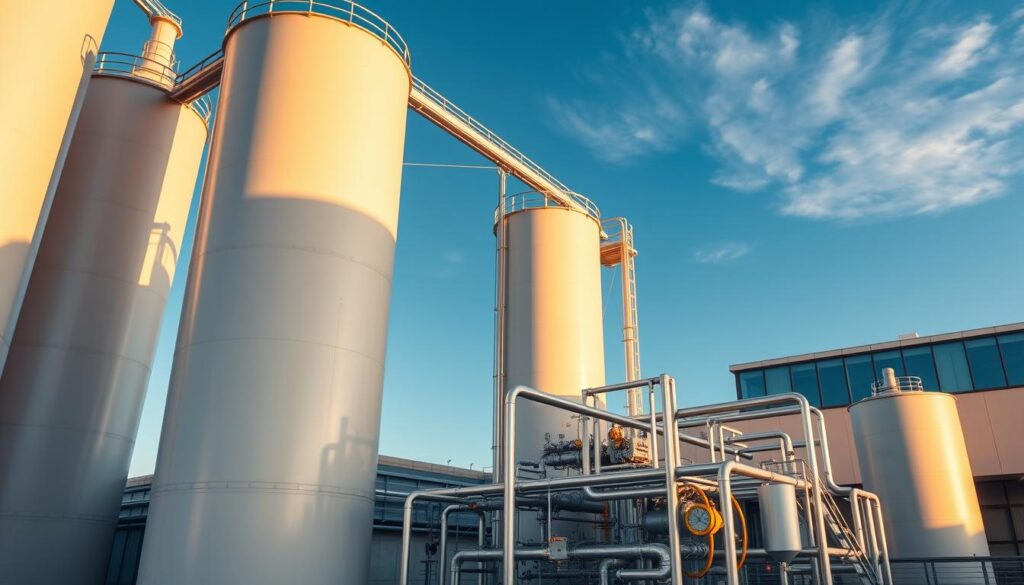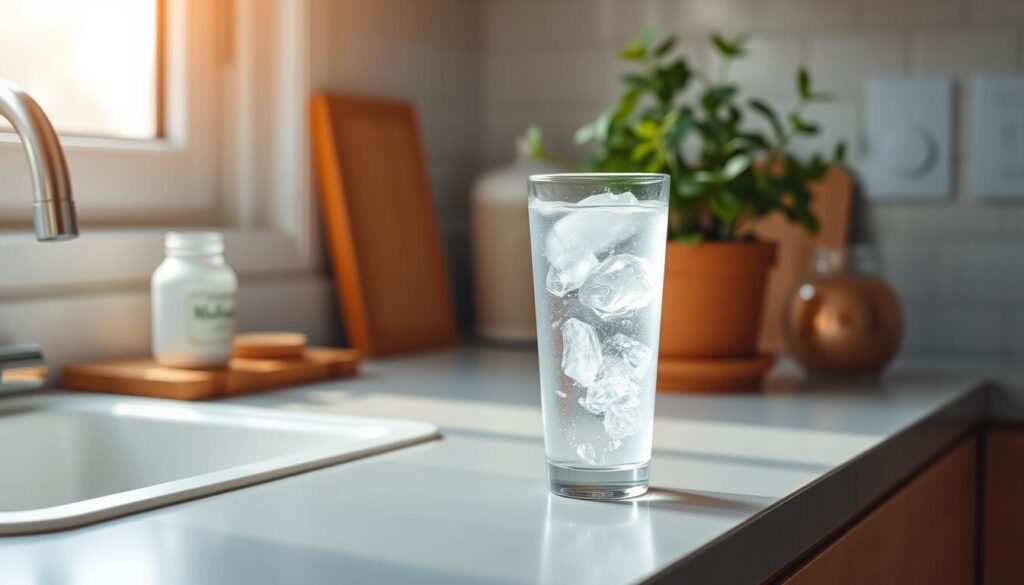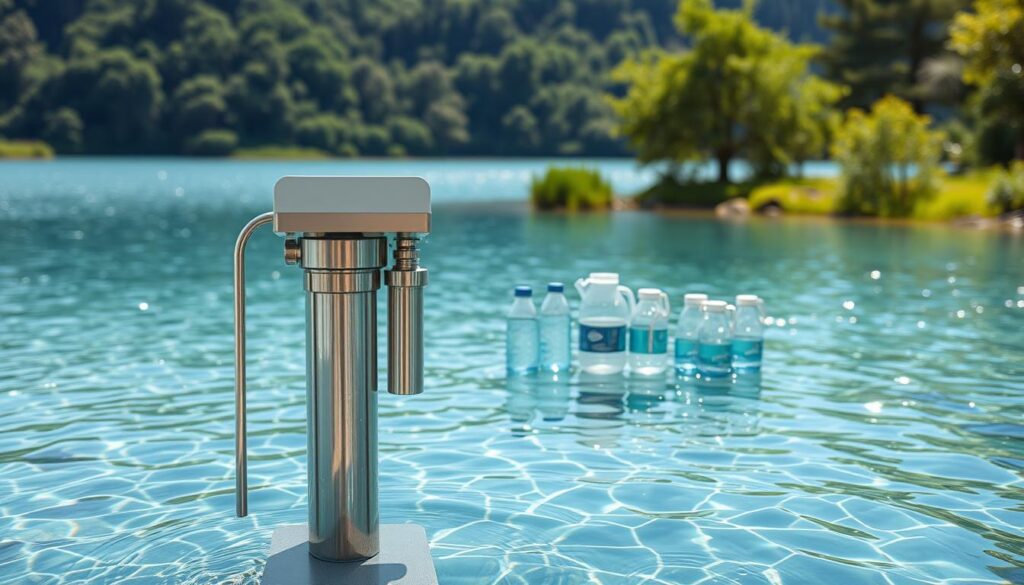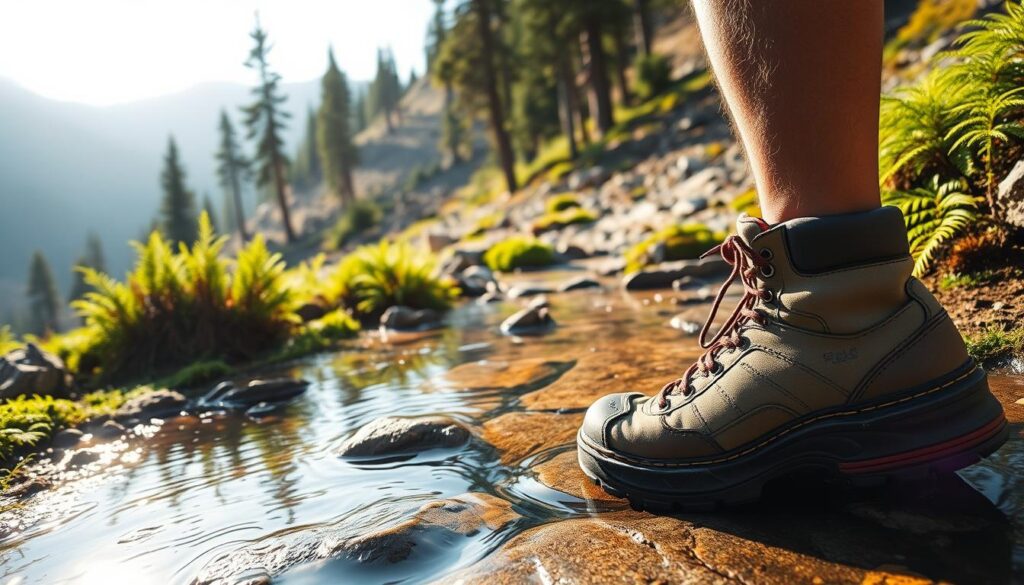Having access to safe drinking water is key for our health and wellbeing, more so in emergencies. As a homeowner, making sure your drinking water is clean is a must.
The Centers for Disease Control and Prevention (CDC) suggest boiling, disinfecting, and filtering to make water safe. I’ve tried these methods and they work well. I’m eager to share my top tips with you.
By using these simple and effective strategies, you can greatly improve your drinking water quality. In this article, I’ll show you the best ways to get safe and healthy drinking water at home.
Key Takeaways
- Boiling water is an effective method for killing bacteria and viruses.
- Disinfecting water with chlorine or other disinfectants can also make it safe to drink.
- Using a water filter can remove impurities and improve the taste and odor of your drinking water.
- Regular maintenance of your water purification system is key for its effectiveness.
- Combining multiple methods can provide the best results for safe drinking water.
Understanding the Importance of Clean Drinking Water
Clean drinking water is key for a healthy life. It’s not just about staying hydrated. It also affects our health and the environment in many ways.
Health Benefits of Clean Water
Drinking clean water is essential for good health. It helps remove toxins and keeps our body temperature right. It also helps our organs work well.
But, bad water can cause many health problems. This includes diseases like cholera, typhoid, and dysentery.
Clean water is also good for our skin, hair, and body. It keeps our skin moist and healthy. It also helps our digestive system work right.
Environmental Impact of Water Quality
The quality of our drinking water affects the environment. Water pollution harms humans, animals, and plants. It can destroy habitats and hurt many species that need clean water to live.
Testing our water is very important. It helps find and remove harmful substances. This keeps our water safe to drink.
By focusing on clean drinking water, we help the environment. We work towards a healthier and more sustainable future.
Assessing Your Current Water Supply
Knowing the quality of your water is key for your family’s health. As a homeowner, it’s your duty to make sure your water is safe and clean.
The Centers for Disease Control and Prevention (CDC) says to test your water, mainly after emergencies or natural disasters. This step is important to find harmful contaminants.
Testing Water Quality
Testing your water means checking its pH levels, clarity, and for bacteria and viruses. You can use DIY kits or get a professional to do a detailed test.
It’s important to follow the CDC’s guidelines for testing. They recommend testing your water at least once a year. Do it more often if you notice changes in taste, smell, or look.
“The quality of drinking water is a critical factor in maintaining public health. Regular testing and monitoring are essential to ensure that water supplies remain safe and free from contaminants.”
Identifying Contaminants
Water can have contaminants like lead, chlorine, nitrates, and harmful microbes. These can get into your water from old pipes, farm runoff, or bad waste disposal.
| Contaminant | Potential Health Risk | Common Sources |
|---|---|---|
| Lead | Neurological damage, developmental issues | Aging pipes, plumbing fixtures |
| Chlorine | Respiratory issues, cancer risk | Water treatment processes |
| Nitrates | Blood disorders, cancer risk | Agricultural runoff, fertilizers |
Knowing about common contaminants and their sources helps you take steps to reduce them in your water.

Regular testing and monitoring keep your drinking water safe and clean. Being proactive helps protect your family’s health.
Filtration Systems: An Overview
Many contaminants are in our water, making a water filtration system essential. It’s not just a luxury; it’s a must. Knowing about the different filtration systems helps keep your water clean and safe.
Filtration systems remove harmful substances from water. They make sure the water is safe to drink. The best system can catch a wide range of contaminants, from big particles to tiny chemicals.
Types of Water Filters
There are many water filters out there, each working in its own way. Here are some common ones:
- Activated Carbon Filters: Good against chlorine, taste, and smell.
- Reverse Osmosis (RO) Filters: Gets rid of dissolved solids and other impurities.
- Ultraviolet (UV) Filters: Kills bacteria, viruses, and other tiny organisms.
- Ceramic Filters: Takes out particles and microorganisms.
Water quality experts say, “The right filter depends on the contaminants in your water.” (
This highlights the need to test your water first.
)
Choosing the Right Filter for Your Home
Choosing the best water filters for your home is important. You need to think about the contaminants, how fast the water flows, how easy it is to maintain, and the cost.
| Filter Type | Contaminants Removed | Maintenance Cost |
|---|---|---|
| Activated Carbon | Chlorine, Taste, Odor | Low |
| Reverse Osmosis | Dissolved Solids, Heavy Metals | Medium |
| Ultraviolet (UV) | Bacteria, Viruses | Low |
Knowing about different filtration systems helps you choose the right one. It’s key to think about what you need and pick a system that fits those needs.
Regular Maintenance of Filtration Systems
Maintaining your water filtration system is essential for clean drinking water at home. Regular upkeep extends your system’s life and keeps your water free from contaminants.
Importance of Changing Filters
Changing filters as recommended by the manufacturer is critical. Filters get clogged with contaminants over time. This reduces their effectiveness and can let harmful substances into your water.
- Check your filter’s condition regularly.
- Replace filters according to the manufacturer’s schedule.
- Consider upgrading to filters with higher contaminant removal capabilities.
Cleaning the System
Cleaning the system is also key. It removes buildup and bacteria. This includes sanitizing the system and checking for worn-out parts.
- Sanitize the system according to the manufacturer’s instructions.
- Inspect the system for any signs of wear or damage.
- Replace any damaged parts to maintain the system’s integrity.

By following these tips, your water filtration system will keep providing clean, safe water. Regular maintenance is an investment in your health and well-being.
Water Softening: Is It Necessary?
As a homeowner, I’ve often wondered if water softening is a must for clean drinking water. It really depends on your water’s hardness.
Water hardness comes from minerals like calcium and magnesium. These minerals aren’t bad for you but can clog pipes and appliances. This is why water softeners are useful.
Benefits of Water Softeners
Water softeners have many benefits, mainly for those with hard water. Some key benefits include:
- Less scaling in pipes and appliances means they work better and last longer.
- Soft water is kinder to your skin and hair, making them feel softer and cleaner.
- Cleaning is easier because soft water makes detergents work better.
A study found that homes with water softeners had less soap scum and scaling. This made their lives better.
“Softened water not only improves the longevity of appliances but also enhances the overall comfort of living by reducing the effort needed for cleaning.”
How to Choose a Water Softener
Choosing the right water softener involves looking at a few things. These include your household size, water hardness, and budget. Here are some important things to think about:
| Factor | Description | Consideration |
|---|---|---|
| Household Size | Bigger homes need stronger softeners. | Find a softener that fits your home’s needs. |
| Water Hardness | Harder water means you need a more efficient softener. | Check your water hardness to pick the right one. |
| Budget | Water softeners vary a lot in price. | Match your budget with the features you need. |
By thinking about these points and knowing the benefits of water softeners, you can decide if you need one for your home.
The Role of Municipal Water Supply
Ensuring clean drinking water starts with understanding the municipal water supply’s role. It’s key to know how these systems work and their impact on water quality. This knowledge is vital for homeowners.

The municipal water supply treats and distributes water to homes. It involves several steps. First, water is sourced from natural resources. Then, it’s treated to meet drinking water standards. Lastly, it’s distributed through a network of pipes.
Understanding Local Water Quality Reports
Local water quality reports are very important. They give info on the safety and quality of water. These reports include data on contaminants, treatment, and compliance with laws.
To get these reports, homeowners can contact their local water utility or visit their website. Reviewing these reports helps homeowners understand their water’s quality. It also helps identify any issues.
Advocating for Better Water Standards
Advocating for better water standards is key. Homeowners can make a difference by staying informed and participating in public meetings. Supporting policies that focus on water quality is also important.
By working with local authorities and others, communities can improve water treatment and distribution. This leads to safer and cleaner drinking water for all.
Exploring Alternative Water Sources
Looking into alternative water sources can really help improve your home’s water quality. It’s key for homeowners to check these options to get clean drinking water.
Rainwater harvesting is a great choice. It collects and stores rainwater for drinking, cooking, and more. This method cuts down on using city water and helps prevent flooding.
Rainwater Harvesting
Rainwater systems can be simple or complex, based on your needs. A basic setup might have a roof catchment, a tank, and a filter. More advanced systems add steps like UV purification for safe drinking water.
Bottled Water: Pros and Cons
Bottled water is another option. It’s easy to find and seems pure. But, it’s pricey and adds to plastic waste, harming the environment.
Thinking about bottled water means weighing its good points against the bad. Some find it worth it for the convenience and safety. Others might prefer a home filter or rainwater system for cost and eco-friendliness.
In summary, checking out rainwater harvesting and bottled water can guide homeowners to the right choice for their water. Knowing the benefits and drawbacks helps pick the best option for clean drinking water.
Making Clean Water Accessible
I’ve found that making clean water accessible is about finding affordable and simple ways. These methods don’t need a lot of money.
Choosing affordable filter options is a smart move. There are many water filters for different budgets. For example, activated carbon filters are cheap and good at removing bad tastes and smells. Learn more about clean water at ways to provide clean water.
Affordable Filter Options
There are many affordable filter choices:
- Pitcher filters: They’re easy to use and keep up with.
- Faucet-mounted filters: They make filtering water from the tap easy.
- Under-sink filters: These are a long-term solution that can save money.
DIY Filtration Solutions
If you like doing things yourself or need a quick fix, DIY filtration is a good option. Here are some simple ideas:
- Boiling water: It’s a simple way to make water safe to drink.
- Sand filtration: You can make a sand filter at home with a container, sand, and charcoal.
- Ceramic filters: You can make these at home to filter out bacteria and other bad stuff.
By looking at both affordable filters and DIY methods, you can make clean water available to your whole family.
Hydration: How Much Water Do You Need?
Drinking enough clean drinking water is key for good health. But, how much is the right amount? It depends on your age, sex, weight, and how active you are.
Knowing how much water you need each day is important. Health experts suggest drinking a certain amount to stay hydrated. For example, the 8×8 rule is popular, which means eight 8-ounce glasses a day.
Daily Water Intake Recommendations
The amount of water you need can change based on your activity level and where you live. For instance, if you’re very active or live in a hot place, you’ll need more water. The National Academies suggest women drink 2.7 liters and men drink 3.7 liters of water each day.
- Check your urine: If it’s pale yellow or clear, you’re hydrated.
- Listen to your body: Feeling thirsty means you need to drink more.
- Drink more when active: Increase your water intake during and after exercise or in hot weather.
Keeping Track of Your Hydration
To make sure you drink enough water, try using a hydration app or set reminders. Some people also carry a refillable water bottle to remind them to drink more.
By paying attention to your hydration needs and making small changes, you can ensure you drink enough clean drinking water. This supports your overall health.
Educating Family and Community
Learning about water safety is as vital as having clean drinking water at home. It’s not just about having a good filter or drinking enough water. It’s also about teaching others what we know.
By sharing knowledge about water safety, we can stop waterborne illnesses and help our community stay healthy. We need to know what can harm our water and how to fix it. For example, teaching my family to test our water regularly helps us catch problems early.
Sharing Knowledge About Water Safety
Community workshops or local events are great for sharing water safety tips. As Dr. Jane Smith, a water quality expert, said, “Community education is the cornerstone of water safety.” These events can really help people learn about keeping water safe.
“The quality of our water is a reflection of our community’s health and well-being.”
When teaching about water safety, here are some important points to cover:
- Understanding local water quality reports
- Recognizing signs of water contamination
- Implementing simple water safety practices at home
Organizing Community Clean Water Initiatives
Starting community clean water projects is also key. We can work with local groups to set up rainwater systems or push for affordable filters. Together, we can make sure everyone has access to clean water.
For instance, a community clean-up event near water sources can cut down pollution and improve water quality. Also, pushing for better water standards with local officials can lead to lasting changes in our water.
By doing these things, we help our environment and build a stronger community. Teaching our family and community about water safety is a never-ending job that needs our constant effort and dedication.
Future Trends in Water Purification
Looking ahead, water purification tech will keep getting better. New filtration methods like Reverse Osmosis (RO) and Nanofiltration are becoming common. These technologies remove harmful substances while keeping good minerals.
Advancements in Filtration
New nanomaterials, like carbon nanotubes, are making water purification even better. Graphene oxide is also being used to boost the power of activated carbon. For more on the latest in water tech, check out Bottleless Nation.
Sustainable Practices
Sustainable methods are key in water purification. We need to use eco-friendly ways that cut down waste and energy use. By following these trends, we can keep our water clean for future generations.
FAQ
What are the health benefits of drinking clean water?
Drinking clean water helps prevent diseases and boosts health. It keeps you hydrated and can improve your skin and brain function.
How often should I test my home’s water quality?
Test your water at least once a year. Do it more often if your water tastes, smells, or looks different. Use a kit or get a professional to test it.
What type of water filtration system is best for my home?
The best system depends on your water’s contaminants. Look at activated carbon, reverse osmosis, and UV systems. Compare them to find the right one for you.
How often should I change my water filter?
Change your filter every 6-12 months, or as the maker says. Regular changes keep your water clean.
Is water softening necessary for my home?
Yes, if your water is hard. It can harm your pipes and appliances. A water softener removes minerals that make water hard.
How can I make clean drinking water more accessible?
Use affordable filters like pitcher or faucet-mounted ones. Or try DIY solutions. A whole-house system also works well.
How much water should I drink daily?
Drink 8-10 cups (64-80 ounces) a day. Your age, sex, and activity level matter. Check your urine to see if you’re drinking enough.
What are some future trends in water purification?
Expect better filters and more sustainable practices. New technologies and rainwater harvesting will improve water systems.
What are the drinking water standards that my tap water should meet?
Tap water must follow the Safe Drinking Water Act (SDWA) in the U.S. Check with your local water utility to see if it meets these standards.
How can I stay informed about my local water quality?
Look at your water utility’s annual report online or ask for it. Also, contact your utility or a local non-profit for more info.



